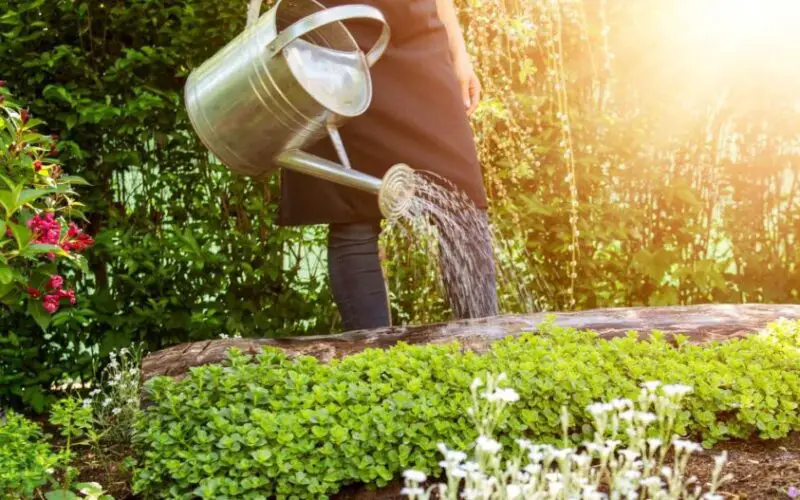Water at the foot of the plants and nothing else… The important thing is to feed the roots (for example via underground watering) and not the plant itself…Why? The leaves are not well protected from the humidity of the night and become more sensitive to diseases while being burned by the sun the next day.
By extension, never water the leaves of plants in the middle of a heat wave, the leaves would be burned by the sun with a magnifying glass effect. Now the question is asked, you need a watering frequency adapted to your plants, according to their water needs. Here is how often you should water your plants:
Contents
How often to water plants?
1. Succulents
How often should you water
Every 10 to 15 days
Good to know
NEVER water your succulents if the soil is still wet. Always wait until the soil is completely dry between each watering. And when the time comes to water your succulents, don’t skimp on water! Flood the plant, then let the soil drain and dry as quickly as possible… kind of like storm conditions in a tropical area.
2. Aloe
How often should you water
Every 10 to 15 days
Good to know
Aloes are succulents. Therefore, follow the same advice as mentioned above.
3. Spathiphyllum (false arum or moon flower)
How often should you water
Every 5 to 10 days
Good to know
Spathiphyllum, also known as moonflower, faux-arum or peace lily, requires moist soil. Allow the soil to dry to a depth of about 2 inches between waterings. If the soil takes longer to dry, it means the spathiphyllum needs more sun exposure.
4. Sansevieria trifasciata
How often should you water
Every 10 to 15 days
Good to know
As with succulents, wait for the soil to dry completely between waterings. While watering, flood the plant and let the soil drain and dry as quickly as possible. Although it does well in the shade, sansevieria is a desert plant that needs bright light and direct sunlight.
5. Lyre fig (Ficus lyrata)
How often should you water
Every 5 to 10 days
Good to know
Let the soil dry to a depth of about 2 inches between each watering. The lyre fig likes to be in full light, even if its foliage tends to dry out.
6. Peperomia
How often should you water
Every 5 to 10 days
Good to know
Let the soil dry to a depth of about 2 inches between each watering. If the soil takes a long time to dry, it means that your peperomia is not getting enough sun.
7. Spider plant (Chlorophytum comosum)
How often should you water
Every 5 to 10 days
Good to know
Water when the soil is dry to a depth of about 2 inches. The spider plant appreciates moist soil. But as with perennials, if the soil takes a long time to dry, your plant is not getting enough light.
8. Calathea
How often should you water
Every 5 to 10 days
Good to know
Water when the soil is dry to about 2 inches deep. NEVER spray the foliage of your calathea, as it is a disease-prone plant. However, calathea does like moist soil. And again, if the soil takes a long time to dry, it means your plant is not getting enough light.
9. Dwarf palm (Chamaedorea elegans)
How often should you water
Every 5 to 10 days
Good to know
Water the dwarf palm as soon as the soil is dry to a depth of about 2 inches. Like most of the plants on this list, dwarf palms like moist soil, but it will take a long time for the soil to dry out if your palm does not get enough light.
10. Lemon and other citrus trees (Citrus)
How often should you water
Every 5 to 10 days
Good to know
Water citrus trees when the soil is completely dry to a depth of about 2 inches, or when their leaves start to wilt or curl. If the soil takes a long time to dry, your plant is not getting enough light or perhaps its pot is not suitable. Citrus roots like to dry as quickly as possible. So, to keep your citrus plants alive longer, use terra cotta pots.
11. Rubber Ficus (Ficus elastica)
How often should you water
Every 5 to 10 days
Good to know
Rubber ficus likes well-drained soil. So water when the soil is completely dry to a depth of 2 inches.
12. Butterfly orchid (Phalaenopsis orchid)
How often should you water
Every 5 to 10 days
Good to know
Spray water regularly on your orchid (every day or two). Once a week, immerse the pot three quarters of the way into a bucket of water at room temperature. Let your plant soak for about 10 minutes, until no more air bubbles escape from the pot.
Be careful, orchids don’t like the sphagnum moss often found in potting soils, as it makes them rot. Therefore, use a suitable potting soil mix with orchid bark instead. Finally, phalaenopsis like rooms with good ambient humidity, like a bathroom with a window. So placed in your bathroom, you can spray it less often.
13. Philodendron
How often should you water
Every 5 to 10 days
Good to know
Water your philodendron when the soil is dry to about 2 inches deep. If the soil takes longer to dry, your plant is not getting enough light.
14. Ficus
How often should you water
Every 5 to 10 days
Good to know
Water as soon as the soil is completely dry, about 2 inches deep. Ficus plants like a good exposure to the sun.
How often should I water my garden in summer?
When summer arrives, we tend to water more abundantly, are we right? Well, yes! In summer, it is better to water infrequently, but abundantly.
On the other hand, daily watering is excessive, even in hot weather, because it disturbs the natural cycles of plants. It is better to water heavily once a week.
Watering in the evening is ideal, especially in hot weather. These limits water loss due to evaporation. As a general rule, you should avoid watering between 11 am and 5 pm, because the stomata of the plants are closed, the water does not penetrate and the droplets may even have a magnifying effect and burn the leaves.
Remember also to mulch your vegetable garden, which will help to fight against the drying of the soil. It is thus alive and rich and requires less watering.
Finally, be careful with potted plants in hot weather: they are more at risk, because the soil does not act as a thermal regulator as it does in the ground.
To avoid overheating plants, move them to a place where they can benefit from a little shade or, at best, choose a water retention tray, which prolongs the hydration of the plant.








